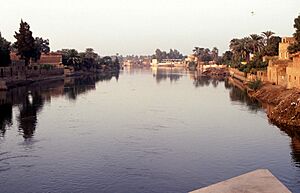Bahr Yussef facts for kids
The Bahr Yussef (which means "the waterway of Joseph" in Arabic) is a very old canal in Egypt. It connects the famous Nile River to the Faiyum Oasis, a fertile area in the desert. This canal has been super important for farming and life in Faiyum for thousands of years!
Contents
A Canal with Many Names
Long, long ago, the ancient Greeks called this canal Tomis. This name came from an old Egyptian word, Tm.t, which meant "ending canal." Even after the Arabs came to Egypt, people still used a similar name, calling it al-Manhi. People also knew it as "the Great Canal" or "the canal of Moeris." Today, its modern Arabic name, Bahr Yussef, refers to the prophet Yusuf, who is similar to the biblical Joseph.
How the Canal Was Formed
In ancient times, before recorded history, the Bahr Yussef was a natural branch of the Nile River. When the Nile flooded, this branch would carry water to the west, creating a large lake.
Around the time of the Twelfth Dynasty (which was thousands of years ago!), people started to make the waterway bigger. They worked on the Faiyum area to make Lake Moeris even larger. This lake is now called Birket Qarun.
The canal was built following the natural slope of the land. It became a channel about 15 kilometers (9 miles) long and 5 meters (16 feet) deep. It gently sloped down into the Faiyum depression. The flow of water was controlled by something called the Ha-Uar Dam. This was actually two dams that helped manage how much water went into the lake from the Nile.
Around 230 BC, the area around the canal changed. The Bahr Yussef eventually became less used and cared for. This caused most of Lake Moeris to dry up. What was left became the depression we see today, which is the modern Faiyum Oasis.
The Canal Through History
Even during the medieval period (the Middle Ages), the Bahr Yussef was still a very important way to travel and connect Faiyum to Cairo. It helped people move goods and communicate across the region.
The Bahr Yussef Today
The Bahr Yussef is still around and working today! It continues to bring water northwards into the Faiyum Oasis. It runs almost parallel to the Nile River, providing life to the desert region, just as it has for thousands of years.
See also
- Sakoula DNC


